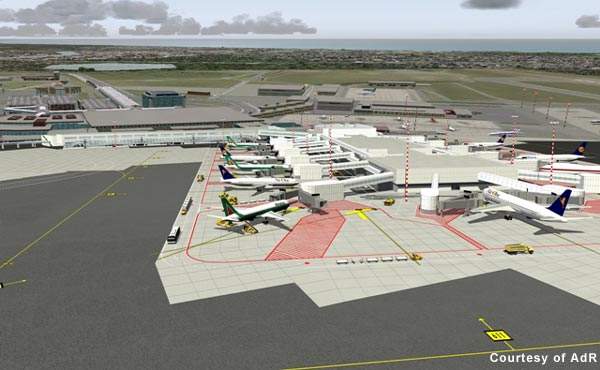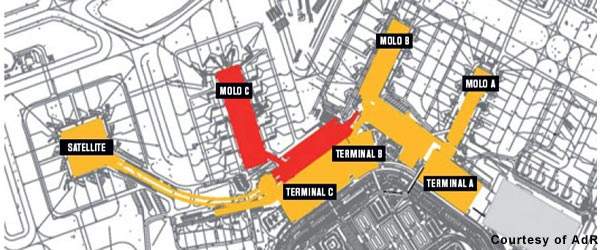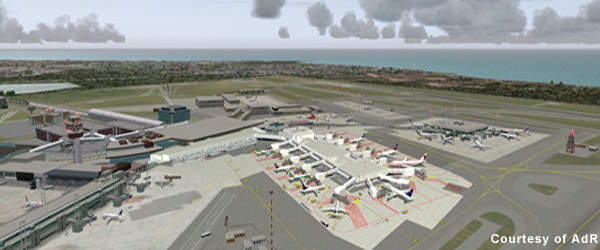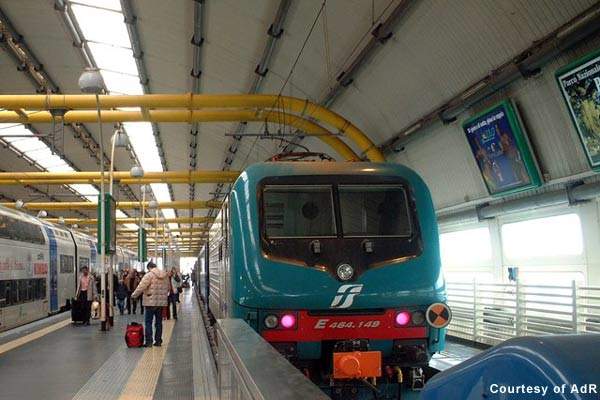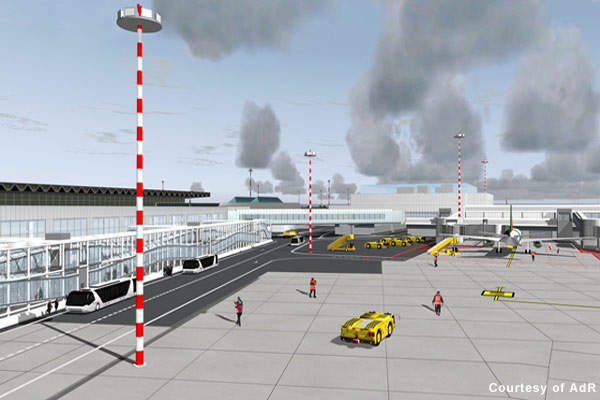Leonardo da Vinci Airport is located in Fiumicino around 35km (22 miles) from the centre of Rome (served by the A91 and an excellent train service). The airport is the largest in Italy and served around 33 million passengers in 2007 (an increase of 9% over the previous year).
The airport has four runways 07/25 3,309m (10,856ft); 16R/34L 3,900m (12,795ft); 16L/34R 3,900m (12,795ft) and 16C/34C 3,600m (11,811ft). Runway 16C/34C is used mostly as a taxiway while 16L/34R and 16R/34L are the main runways and 07/25 is used only in a westward direction when there are prevailing winds.
The operator of the airport, which opened in 1961 taking over from Ciampino Airport, is Aeroporti di Roma (ADR SpA – the main shareholder is Gemina SpA (95.8%)).
There are five terminal buildings at the airport: terminals A, AA, B, C and 5 that handle both international and domestic flights. The airport has undergone a sequence of improvements and expansions since the 1990s. In 1991 the pier A domestic loading bridges were opened (12), in 1995 ten new loading bridges opened on pier B, 1999 saw a new sky-bridge train and a west satellite with 11 loading bridges on satellite C, in 2000 the new domestic terminal A opened and the terminal designations were rearranged into their current form. In 2004 a new cargo terminal was opened at the airport and was called Cargo City.
Terminal 5
In April 2008 the new 14,000m² terminal 5 was opened (designed by AdR Engineering), which was designed to handle 950,000 passengers a year. The project required an investment of €10m and took a little less than six months to complete.
The terminal has completely separate check-in, security passport control and baggage handling systems (1,800 units an hour) allowing it to be used as a completely dedicated international terminal.
Runway refurbishment
In January 2008 a project was undertaken to improve runway 16R/34L at the airport to allow the operation of larger aircraft such as the A380. The works included renovation of the asphalt layer and construction of new internal taxiways as well as new runway lighting to allow take off in Cat III visibility conditions (75m visibility).
The work was completed by April 2008 under the direction of ENAC (Italian Civil Aviation Authority) and ENAV (Italian Flight Control Authority).
Pier C
The new pier C construction will provide new terminal space, which will be dedicated to Schengen (intra-EU) flights (later the facility will serve non-Schengen flights). This will have 16 loading bridges and eight remote boarding gates and will allow the airport to handle its target of 55 million passengers a year by 2018.
The construction work will be completed by 2011–2012, and will see a total area of 78,000m² added to the airport buildings in two phases. There will be an extension of terminal C (200m × 40m) of 22,000m² (first phase), which will house a new baggage handling system and also pier C itself (280m × 70m) which will form the boarding area for five million passengers a year (second phase).
In pier C 4,400m² will be used for retail concessions and 4,190m² for new meeting rooms and VIP lounges. The basement of the new pier will also provide an area for baggage handling and a baggage security holding area. It is likely that pier C will be connected to the rest of the airport using the existing automated people mover at the airport.
The works are being undertaken by Cimolai SpA under the supervision of AdR Engineering and the estimated construction costs are €195m. Additional contractors involved in the implementation of the project include: The Design Solution (design of retail areas), Pragma Consulting and also the UK based project management firm Arup.
The European Investment Bank (EIB) has granted a loan of €80m to the airport for their improvements in the period from 2008 to 2017 Industrial Plan and the loan has been secured by Banca Infrastrutture Innovazione e Sviluppo SpA. (BIIS, Gruppo Intesa Sanpaolo).
Future projects
In early 2008 a budget of €149m was agreed by the airport authority to fund a number of other smaller projects at the airport.
These projects will include: a second office tower to house the airlines and their staff, which is expected to be open by September 2008, a new cogeneration system allowing the airport to produce its own environmentally friendly energy (open by the end of 2008) and a new baggage handling system in place by 2009.

